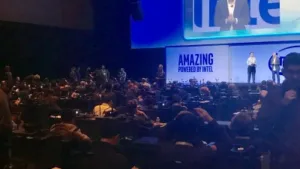In case you missed it, at CES 2017 Intel hosted the most “unique and technically complex event” the company has ever held, according to Laura Anderson from Intel corporate communications. She kicked-off the 45 minute CES press event where CEO Brian Krzanich hosted 250 journalists with a presentation dedicated entirely to Virtual Reality.

Remarkably, the company included an Oculus Rift headset at every (plush leather) seat in the massive Mandalay Bay ballroom with a menu of VR content examples the company calls ‘merged reality’.
To make the point, the company presented to the journalists a live VR feed of the ongoing NCAA Villanova-Butler basketball game. The event was streamed with the help of Intel’s recently acquired Voke virtual reality capture technology and its TrueVR platform. It enabled a live sports experience on all of the 250 VR devices at the Las Vegas event with the help of the technology Intel acquired in November 2016. To the chagrin of Krzanich, the game hit half-time just as his presentation was ready to show the action. The VR stereoscopic and panoramic camera was placed at two locations, one in the stands, where the sports action could be seen, and other fans were in clear view with the simple turn of the head. Pretty cool. The only down side was I couldn’t grab a beer from the vendor passing by. Dang!
250 VR headsets used by Intel at their 2017 CES Press event, Source S. Sechrist“Sports is being revolutionized by data and the ability to capture, connect, analyze and interact with it. We call this the digitization of sports,” according to James Carwana, manager of Intel’s recently created sports business unit. He said the company is looking to develop a portfolio of “best-in-class solutions” that create an immersive sports experience, not just for the fans but is to also include, content producers and even sports officials and athletes.
Other content options shown included a live action VR exploration of the Ban Gioc waterfall in Vietnam. Here, company partner HypeVR showed off its proprietary volumetric capture and playback engine showing live action VR feed where “…viewers could freely walk around in a live-action, non-artist created CGI video.” We were told it was the “first public demonstration” of this technology.
Indeed we could move in, out, and around the 3-D scene with things changing as we changed our visual perspective. I even saw an old war-era oil drum with faded lettering and that looked as though it came from an abandoned army base. To that end, Intel and HypeVR, a computer vision company focused on developing ultra-high-resolution live action VR capture and playback with six degrees of freedom and announced that they are looking to partner to bring HypeVR volumetric video content to Project Alloy in 2017. Intel said “the experience foreshadowed the future of video and a different way in which content potentially will be created for VR,” and while the movement and changing perspective was impressive, resolution was still a bit low, so there is a way to go here.
Other VR demonstrations included a live inspection of a desert solar farm on the Moapa River Indian Reservation, from Orah 4i high-definition cameras and a low-power, high-latency computing solution mounted on a flying drone. One over the shoulder look disclosed the team of field engineers and drone pilot flying the vehicle real time. What was missing was live interaction with those guys on the ground before take-off, or after landing. Still, flying over a massive solar panel farm in the desert with a 360º field of view was impressive, and demonstrates the power of VR in the B to B space. It also served as the most compelling reason for VR, although the B to B niche won’t provide the mass adoption numbers the industry likes to see in generating returns from it’s mass dollar investment.
If CES is any indication, for Intel the VR train has left the station, with the company betting on virtual reality empowered systems (mobile to desktop) to lead the next wave of (mostly) consumer demand and drive chip sales for the silicon behemoth, with the rest of the industry in tow. Steven Sechrist

